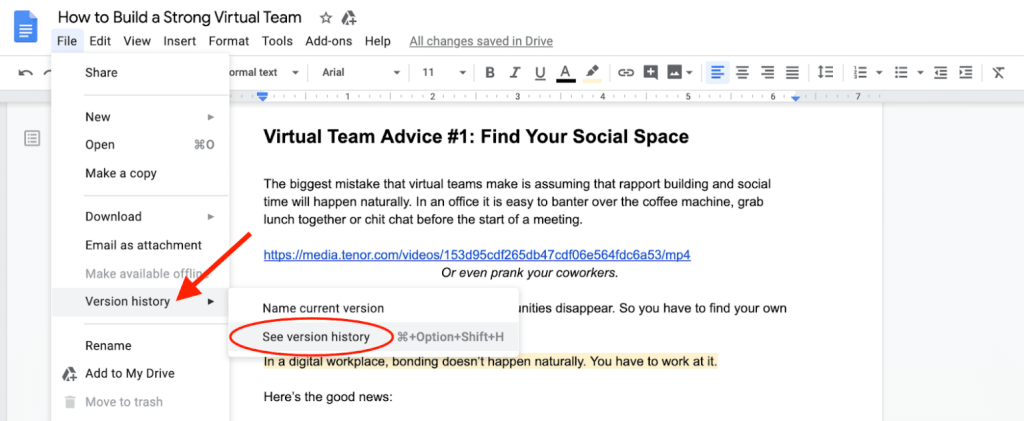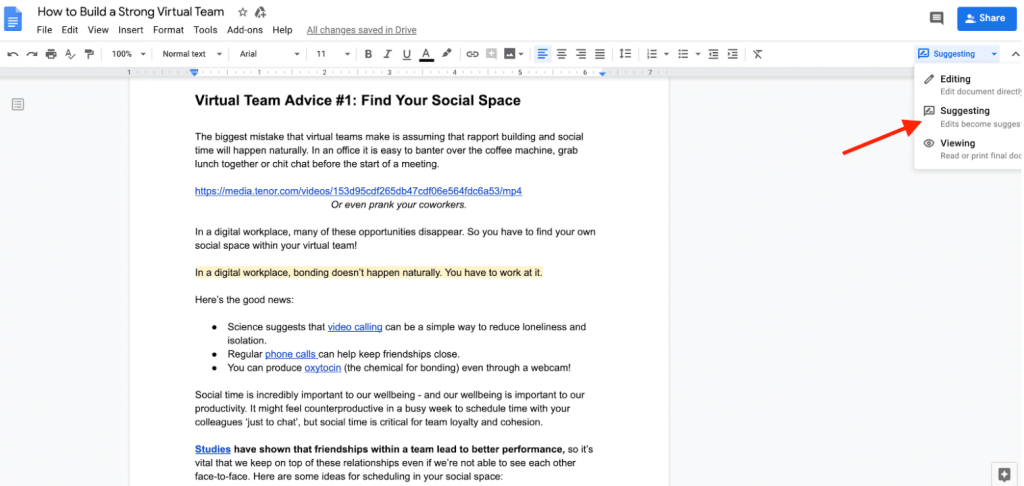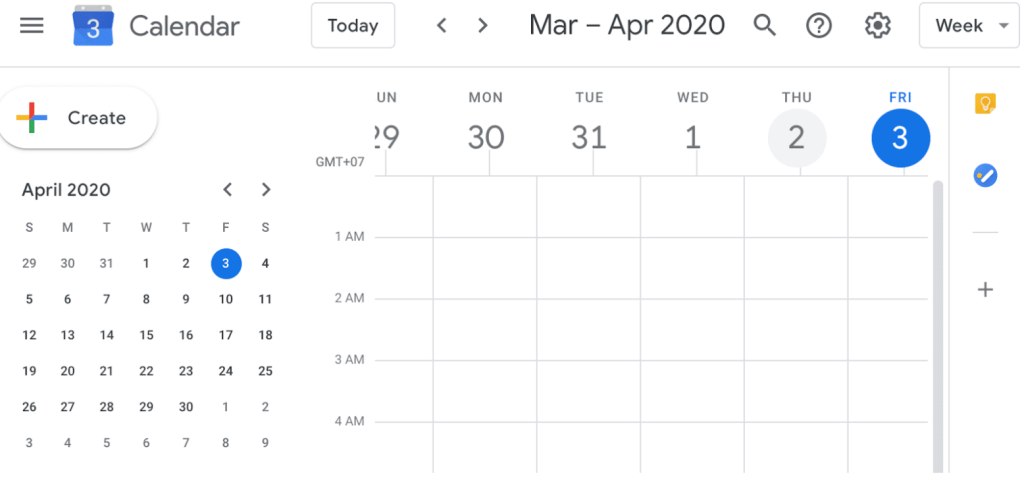This is part of our Remote Work Guide. Click here for more.
Remote Work Guide
Start learning everything you need to know about Remote Work.
As more companies begin to work remotely, we need to know how to work effectively in a virtual team.
More and more of us are working from home and this means knowing how to adapt.
Studies have shown that working from home can also lead to a happier, more productive virtual team.
What is a Virtual Team?
A virtual team is a group of remote workers who collaborate together to finish a project. A good virtual team is able to communicate effectively using apps or software and can consist of employees from a single company or employees of different companies.
Getting virtual teams right relies on two factors:
- Access to the right technology
- Using clear digital communication
Achieving these two things will mean you’re able to collaborate effectively in a virtual workplace.
Here’s how you do it.
Create A Social Space
The biggest mistake that virtual teams make is assuming that rapport building and social time will happen naturally. In an office it is easy to banter over the coffee machine, grab lunch together, or chit chat before the start of a meeting.
Or even prank your coworkers.
In a digital workplace, many of these opportunities disappear. So you have to create your own social space to avoid the social battery drain within your virtual team!
In a digital workplace, relationships are like batteries. They drain and you must constantly recharge them.
Scott Edwards, Science of People CEO
Here’s the good news:
- Science suggests that video calling can be a simple way to reduce loneliness and isolation.
- Regular phone calls can help keep friendships close.
- You can produce oxytocin (the chemical for bonding) even through a webcam!
Social time is incredibly important to our well-being, and our well-being is important to our productivity. It might feel counterproductive in a busy week to schedule time with your virtual group “just to chat,” but social time is critical for team loyalty and cohesion.
Studies have shown that friendships within a team lead to better performance, so it’s vital that we keep on top of these relationships even if we’re not able to see each other face-to-face. Here are some ideas for scheduling in your social space:
- Carve out the first 10 minutes of every meeting for personal catch-ups.
- Learn together! Send around your favorite TED Talk to your team so people can watch on their own (I love this TED Talk, but I’m a bit biased). Then have a lunch discussion where you talk about what you learned.
- Do more one-on-ones and add personal questions to the agenda. Ask about goals, hobbies, and family.
- Have a digital coffee break.
- Have lunch together.
- Bring in a speaker or guest expert to host a lunch and learn. (I do these for teams ALL THE TIME! And would love to meet your team.)
- Do a non-awkward icebreaker to warm-up your meetings.
For the Science of People team, we even have film days every couple months and we use these opportunities both to celebrate and check on personal and professional updates.
It might feel a bit strange at first to schedule a long distance coffee break with your colleagues, but it’s important that we keep our team bonded. After all that is said and done, you might still be wondering…
How Do I Motivate Virtual Team Members?
Knowing how to motivate virtual team members is essential for team leaders. First, you need to know how to motivate yourself. We are inspired by highly productive, efficient people.
Second, learn your team’s personality type. I have led hundreds of virtual corporate trainings for remote teams, including Microsoft, Automattic (thanks for building this entire website!) and Google. One of the most motivating exercises we have done is team personality science.

I would love to speak to your group virtually or you can lead your team through our personality exercise.
Be a Videoholic
Each Tuesday, my team pops on Zoom, a videoconferencing platform, to share updates and to brainstorm new ideas for the business. Of course, we still communicate via other channels such as email and phone, but video allows for a more visual experience among the team. I especially recommend video calling new online network contacts.
Video calling is recognized as a better way to host meetings compared to standard phone calls.
Here’s why video calling is so important:
- Body Language. Video calling offers a more natural interaction, where callers can make eye contact and read body language. For example, if I share news and one of my team members shows a surprised expression, I know the news was shocking or surprising. I’m able to tap into the emotional needs of my team that I wouldn’t be able to do as easily with written communication alone. Or if I see someone nod their head yes or no, I know that they are either in agreement or disagreement regarding a matter.
- The right mindset. One of the most common pitfalls of working from home is finding it harder to keep a routine, and some people start to ditch their office clothes, preferring to work in pajamas (some studies suggest this might be as many as 60% of home workers). This can make people feel less productive as they struggle to get into the right mindset for work. However, regular video conferences encourage us to dress up a bit for the meeting, and feel a little bit more like we’re going to work.
- Microexpressions. There are 7 universal facial expressions and they are incredibly important for decoding and understanding emotions. If you are on video call you can actually read them!
And you can make video better! Check out our guide to making your video calls amazing.
15 Tips Before Your Next Video Call
Pick the Right Tools
What’s one of the biggest challenges for virtual teams? Finding the right technology for the right job! Luckily, there are tools that can transform unproductive teams into successful virtual teams.
With almost 69% of companies already offering remote working as an option, there are lots of tools out there to keep you connected to your team.
I highly recommend trying all of these for your virtual team and then selecting what works best. I am also a fan of using more than one type of digital communication and aligning them with the right tasks. For example, brainstorming sessions should always be done on video chat (to see body language and faces), while agendas can be worked on asynchronously over email, and quick clarifications are best over chat.
Here’s the bottom line: Pick the right tool that works for the task.
Choose Your Chat Tools
Sometimes, you will just need to send a few quick back and forth messages to your teammates. It doesn’t need to be complicated: for these kinds of conversations, pick a good chat service. We love Slack or Twist, though if you’re already using Gmail, it has a helpful chat built into it called Google Hangouts.

Action Step: During your virtual meetings, don’t be afraid to spice things up with polls, PDFs and warm-up chats!
Choose Your Workflow Automation Tools
What is workflow automation?
Workflow automation helps you automate all the boring, tedious tasks so you can focus on the important ones. Workflow automation includes software and apps that are efficient and remove the factor of human error. Here are a couple examples of workflow automation:
- Email automation: with email automation, you can send out emails at certain times to certain people.
- Manage leads: for companies selling products, automation tools can help to automatically direct them to the right part of the sales process.
Here’s why workflow automation tools are so important:
If everybody keeps doing the boring, repetitive tasks that could be automated, your entire team will lose valuable time.
Automation tools are a must for effective virtual teams. There are a few really good tools or workflow automation, but we’re particularly fond of Monday, Zapier, and Microsoft Flow. Here’s Monday’s software, which you can use to create an automated task:
You can set up all your task automations at once, and they’ll be automatically performed for you whenever a task is triggered. Automation tools are literally one of the best time-savers!
Collaboration
We really can’t sing the praises for Google Drive enough when it comes to collaborating on documents.
By using the “track changes” feature, you can see exactly the parts of the document your virtual group has been editing:

You can also work in “Suggesting” mode to prevent any permanent edits being made without a collaborator agreeing to the change:

Google Docs is one of the best ways to increase your collaboration. Yay for virtual teamwork!
Project Management
When you’re working towards building a strong remote culture, it’s a good idea to sort out some project management tools.
It can be a lot harder to organize exactly who is delegated to a task, and for what deadline when you’re no longer able to double-check something across a desk.
We find that Asana is the best for project management, but other teams like to use Trello or Jira.
Videoconferencing
When you think of videoconferencing, your first thought might be using Skype, but there are plenty more options these days. Zoom is quickly becoming more popular, as well as Cisco Webex, both of which offer features such as blurring the background (helpful when you don’t want your virtual group to see the state of your kitchen).
Again though, if you’re already using Gmail, Google Meet and Google Hangouts are both impressive but simple-to-use video calling services.
Scheduling
Ok, we’re going to say it again. Google Calendar is brilliant for scheduling. You can control the privacy settings and join individual calendars (for example, “Team A office hours,” and “Meetings”), so all of the events you need to know about show up in your calendar. You can also set reminders, share invites to events, and write descriptions alongside the time and date.

We have even more communication tools you can check out:
The 15 Best Remote Communication Tools
Create a Great Remote Policy
Even if working from home is only temporary, you should have a remote work policy in place. It is expected that we are about to see a significant shift in the number of people working from home permanently. Therefore, it is worth investing the time into collaborating with your virtual team on an official remote working policy.
What Is a Remote Work Policy?
A remote work policy is an agreement usually between an employer and employee that outlines the terms and conditions of work. A remote work policy can be either temporary or permanent, and includes details on how work is to be performed outside the office.
Here’s what a typical remote work policy includes:
- Working hours
- Team workflow outlining exactly who reports to who (and how / how often)
- New parental leave policies
- New sick policies
- The new structure of the work week in terms of meetings and conferences
- Communication expectations
Preparing a document like this really lays the foundation for the sort of communicative and collaborative culture you want for your virtual team while working remotely.
You can find more information on how to create a remote work policy in our guide to managing remote employees:
12 Reliable Tips to Managing Remote Employees
Find Your Movement Groove
We have our new office in the spare room set up, a shiny coffee machine placed carefully next to the computer, a standing desk all pieced together, and we are ready to go!
Well, almost.
One of the harder parts of moving from an office into our homes is how easy it becomes to be inactive. We sit and become prolonged chair potatoes. And it’s bad: scientific studies on prolonged sitting have suggested that sedentary behavior can lead to increased blood pressure, high blood sugar, excess body fat, and elevated cholesterol levels.
And the worst part?
Being sedentary is easy. Exercise is hard. So people just don’t exercise! It’s especially important for remote workers who usually work at home and are sitting all day. But if you are not already in an exercise routine, consider this:
Every minute you exercise is a minute added to your life.
That’s because Harvard researchers found that just 15 minutes of exercise a day can increase your lifespan by 3 years!
Here are some ways you can include exercise into your new work routine.
- Every 30 minutes, try to take a break from sitting.
- Use a stepper or a treadmill under your desk to keep your legs moving.
- Stand, especially when giving online presentations.
- Walk around the house when you take a phone call.
- Buy a jump rope and spend 15 minutes a day skipping.
- Do 10 push-ups every hour.
- Buy a pull-up bar and attach it above your office door. Every time you pass, do a pull-up.
- Watch a yoga routine on YouTube and follow along.
- Try using a standing desk.
The truth is, it doesn’t matter so much what kind of exercise you do, as long as it’s moderate in intensity and you are challenging yourself. If it sounds too much at first, try baby steps! Do just a couple push ups or just 5 minutes of jump rope and go from there.
The bottom line: work is important, but you can’t get work done if your health is suffering.
Recommend Shortcuts
If you can take away the stress-load from others, you’ll be seen as a great player in your team.
In other words, the amount of stress you reduce from others determines your value. Think about it: if you’re adding on work and stress for other people, you’re effectively burdening your team.
But if you find a way to decrease stress, people will turn to you more for help.
What’s a great way to reduce team stress? One great way is by recommending shortcuts.
Shortcuts in workflow. Shortcuts to save time. Shortcuts that hack productivity. For example, I found a great plugin that saved time by cutting down on a lot of manual research! Since this could help one of my team members, I sent it to him and as a result, his efficiency improved drastically! (And his stress-load reduced as well!)
Action Step: Find and recommend one great shortcut to a coworker, manager, employee, or boss. If they like it, great! You helped and showed value. If they didn’t like it, no harm! It also shows you are being proactive and have a genuine desire to help.
Avoid The Pitfalls
There are a few common pitfalls that remote workers fall into when they join a virtual team. These mostly fall down to two things:
- a lack of routine, and
- lack of good communication.
It’s reported that 40% of remote workers cite “flexibility” as the greatest benefit to working from home.
But, flexibility comes with a downside.
Here’s a scenario:
- You need to hand in a report for 3:00 p.m. It’s 2:45 p.m., and you go to hand in your report.
- But, wait! Your dogs are running around your feet because they need to go out. You take them for a walk, then go to hand in your report.
- But, wait! Your kid is crying, and he desperately wants your attention. You soothe him and go to hand in your report.
- But, wait! Yep, you guessed it. It’s past 3:00 p.m., and your report is now overdue.
Flexibility is fantastic, but there is a major downside to flexibility: distractions.
Setting goals for yourself, time restraints on specific tasks, and keeping your workspace free of distractions is really important if you want to get anything done!
There are a few ways you can do this.
- Make writing a to-do list part of your morning routine.
- Track your productivity by writing down how long you are spending working and having leisure time. If you want to go digital, use an app like Boosted to keep track of your time.
- Set up your home office in a quiet area of the house, free from distractions. It’s best to assign yourself your own room specifically for working so you don’t associate it with anything else.
- Keep your phone in a different room (a study has shown that just the presence of a mobile phone—even if switched off—reduces brain power).
The other greatest pitfall that remote workers fall into is a lack of communication with their team. Not only does this impact workplace productivity, but also your own mental health.
One study suggests that up to 21% of remote workers struggle with loneliness.
We have already established the kind of tools you can use to prevent this from happening, but here are a few social tips on how to handle this.
- Share things about your life outside of work, and encourage other people in the team to do this too. “How was your weekend?” “Wonderful! We finally got to watch that new series streaming on Netflix; have you seen it?” This might sound mundane, but remembering you are more than your job, and your teammates are more than your job, is vital during times of increased social isolation.
- Give other people positive reassurance and feedback on their work. This can be lacking in a virtual team, so really try to boost each other’s morale.
Bottom Line: The things to keep in mind most about building a strong virtual team is the same as you would be doing in the office—keeping your communication effective, your relationship with your virtual group close, and sticking to a routine.
Bonus: Start, Stop, Continue
This is one of my team’s favorite exercises. It’s called Start, Stop, Continue and it works for both virtual and in-person teams. You can do this annually, bi-annually or monthly with your team. Here at Science of People, we revisit this exercise after big business moments, such as product launches and course revamps, to check in with the team regarding tasks.
When you work virtually, it’s easy to get lost in your own work and forget about what the rest of the team is building and creating. This exercise serves as a reminder of the business goals and how each team member’s tasks support those goals.
Check out the full video on Start, Stop, Continue to learn more:
Work remotely? Send this video to your virtual team! Use this as a jumping-off point to start communicating more meaningfully and dynamically with your colleagues.
Happy virtual working,
Vanessa

